Human Flower Project
Sunday Afternoon with Purpose
An autumn walk through Cambridge: stumps into sculpture, token shrubbery, a paucity of tree houses, and a cathedral-sized ash.
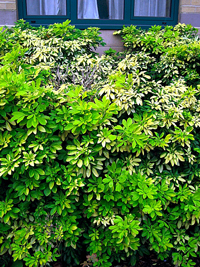 Low maintenance shrub, Milton Road
Low maintenance shrub, Milton Road
Photo: John Levett
By John Levett
It’s the ninth of November and this is the latest in the year, ever, that I’ve gone without switching on the central heating in my flat. This act of self-denial is a combination of choosing not to pay scumbag energy companies more than I have to, choosing to add a further layer of body cladding, counting on the above seasonal average temperatures to take me through to the upcoming capitalist fest and being out of the mood for the annual sellotaping of every draught tunnel between me and England.
Even though it’s reasonably mild and there’s no threat of early snow, my garden life has taken a back seat for about a month. The ramblers need a big cut-back this year and I began back in September making reasonable progress but, as is the way of these affairs, once you drop out of the habit of ‘a little but often’ it seems to take an age to drop back in. This year has been full of commitments to the groups I convene, exhibition organizing, personal art projects, workshops, meetings and meetings about meetings—nothing that I haven’t voluntarily entered into but draining nonetheless. I’ve sought and found islands of calm and the copacetic only to rustle up some exploration that sends me off again. Plus ça change …
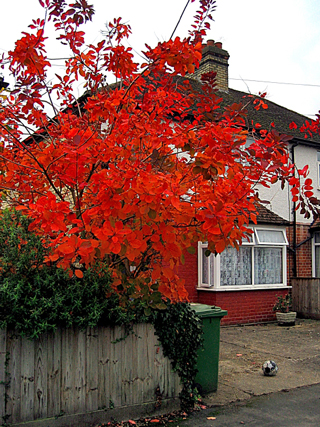 Chesterfield Road
Chesterfield Road
Photo: John Levett
I walk lots during autumn and winter; it’s my time of year despite the moaning. A few years back I used to take holidays in Germany in November through to December and many of the photographic detours that I make on the outskirts of London now I take in December and January. I’ve recently been re-reading a catalogue of an exhibition at the Royal Academy in 1997 of Braque’s late paintings. The painter stayed in Paris throughout the war. There is one painting from 1942 called Le Poêle (The Stove) of the interior of his studio that seems to point up the bleakness of these years; all interiors, mostly subdued hues (he mixed ashes with his paints), getting on with work, confronting indeterminacy, much waiting. The onset of winter (or its early indicators) can involve that—waiting for its arrival, waiting for its end. Lost time; if you allow it. Some cities seem to welcome winter; I always felt that Berlin was one of them. I’ve got plans to start my German travelling again next year, so out have come the language primers and the daily practice—“Bird by bird” as Anne Lamott’s father would have said.
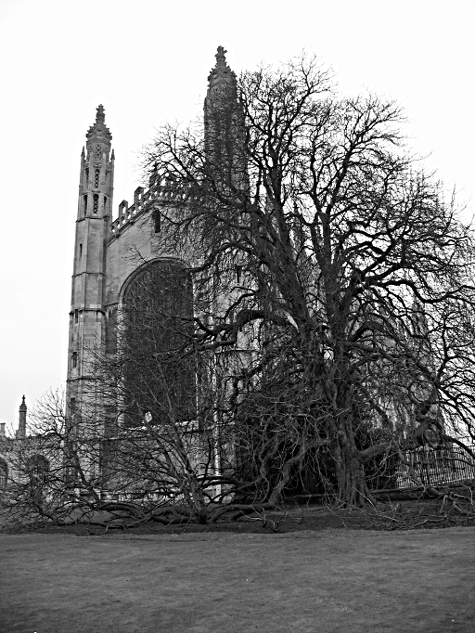
King’s Chapel and its ash tree
Photo: John Levett
Which brings me, without any apparent lead-in, to last Sunday, which appeared to have no promise except grey sky, threat of rain and extra layers. Go out and see what you can find, don’t think much and snap it.
Let’s get the colours out of the way first. We’ve still got colour in all the right places, which means mostly on trees. We don’t have Vermont in this place but we’ve got trees that do a decent dance each Autumn. What’s more interesting is the scaffolding once the leaves have gone. There’s a magnificent ash tree in front of King’s College chapel that has layered itself by the weight of its own branches and the totality of its ‘construction’ acts as a foil for the east window of the chapel. On less grand scales, the same effect appears in the small garden—the skeleton revealing the complexity of the growth, the constraint of the environment, the incursions of traffic, the facts of light, the absence of interference.
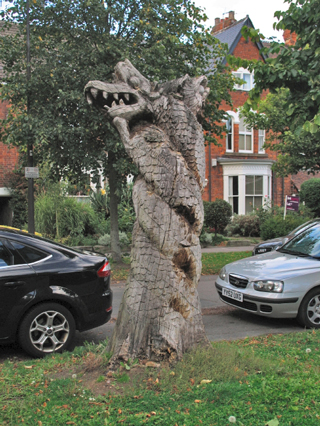 Stump sculpture in Hull
Stump sculpture in Hull
Photo: John Levett
It’s taken as almost incidental that the tree features in the urban landscape, having arrived without clear human agency or, if so, then in some random pattern or a convenient mode of filling a gap. There’s been a lot of tree felling in Cambridge recently. They’ve been replaced by new growth but the loss of the ‘architecture’ of the commons has been a source of contention. (I noticed in Hull recently that ‘decommissioned’ trees have been turned into sculptures by local artists.) A lot of large new-build developments have the token landscaping of plant-a tree-plant-a-low-maintenance-bush approach to the communal garden feature but a few pay more than cost-cutting regard to the quality of the non-built space.
Just past the Milton-Road-sponsored roundabout planting, there’s a small collection of roads not far from the river and the Elizabeth Way bridge in East Chesterton that were built in the years immediately after The Great War. I’m guessing that the trees are of the same age, dominating the small villas. The public landscaping of an urban area is crucial to its character, its housing of wildlife and the general natural ecology, its human ecology, one’s passage though the space and one’s behaviour within it. It is also a pacifying agent not only by virtue of its existence but in combination with other features. A bench under a tree in my neighbourhood was a common meeting place for the children of the block; some residents thought it was a source of anti-social behaviour, a rubbish trap and all manner of atrocities. The bench was removed to the disgust of other residents who used the bench early morning after seeing the kids off to school and the ones who used it during the day whilst the kids were in school — parents, oldies and the children rotated. Who won?
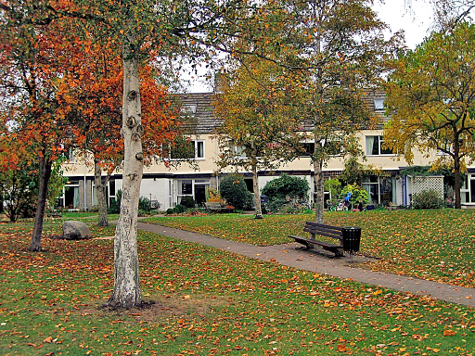
Landscaping at New Chesterton, the bench remains
Photo: John Levett
It’s strange the way that some ‘garden features’ retain their prominence beyond the need—the hedge sticks out. What does one do with a hedge except cut it? There are creative hedge-growers but they’re few; most just cut hedges and most can’t see the point of the cutting except that the hedge needs it. I have a hedge outside my den window; the council cuts it every month. Curiously, some ten years ago when the council wanted to plant an alternative low-maintenance scheme I said that I preferred the hedge. Bizarre!
What happened to the tree-house? I recall that up to the age of ten my mother, gran and I lived in Luton, and at the back of the small grocer’s shop that mum ran was an orchard. The Burkinshaw boys from next door and I spent an age trying to get wood (plentiful from the bomb site opposite) up the tree and secure it there. We got close to hanging ourselves at some point, and the first aid box was in frequent use but no joy with the house. Whatever happened to kids building stuff? Beyond the tree house was Meccano, Bricklayer, seed sowing, balsa modelling (with accompanying glue-sniffing!), anything modelling, marquetry, boat building, solid-fuel Jetex rocketry. I don’t see these things getting done these days. Kids don’t want to build? Just round the corner some of the children have begun small roadside gardens around the new saplings that have been planted. Problem is we’re too risk-averse these days—“Something might happen.”
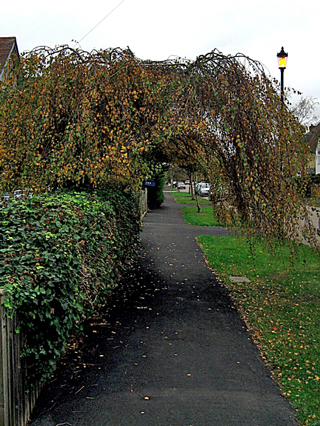 Encroaching tree, Hurst Park
Encroaching tree, Hurst Park
Photo: John Levett
Then comes the front garden. I’ve little idea about the history of the front garden in British suburban culture: perhaps a descendent of the earthwork or the moat, I guess, a breathing space between our plot and the world, and making the world less of a threat. The back garden feels safer with its fencing but the front is a plot that’s open to depredations and invitations. I can remember the house I had in Hitchin. It was on the way to a local school, and one of the mothers on her way back from delivering the children always snipped a rose from the front. This wasn’t just a casual nicking but one with malice aforethought, armed with tools for daylight rose theft. The front often gets paved these days and acts as the car pool. What’s to be done? Do something anyway and make it as complicated as you can. No tokenism or specimen planting; no picky little tubs to get waterlogged; no bike racks or builders rubbish. Announce your intention. If it has to be a tree, then let it boldly encroach.
When I came home from the walk there was a bunch of kids trying (and succeeding) to get onto the warehouse roof from the bit of waste land next to my flat. I did my adult bit of pointing out the life-threatening consequences of falling off it or through it but couldn’t bring myself to do much else; betting on boredom winning. “Why don’t you build a tree house?”

